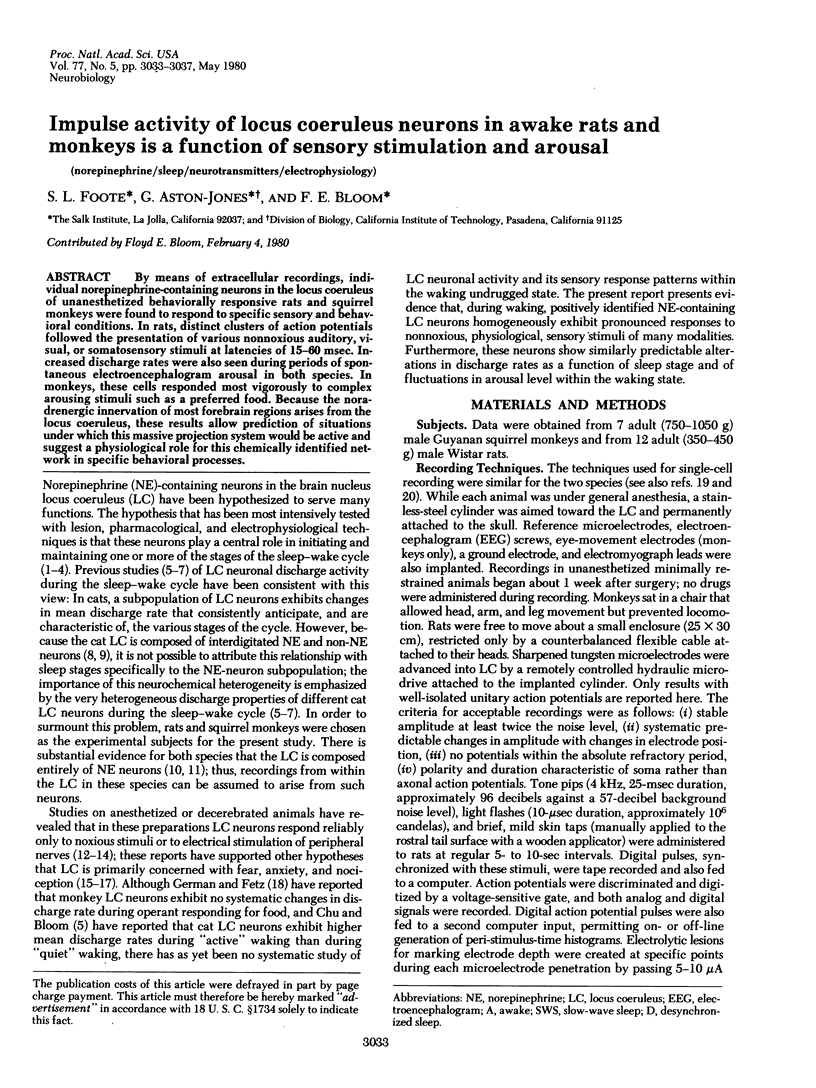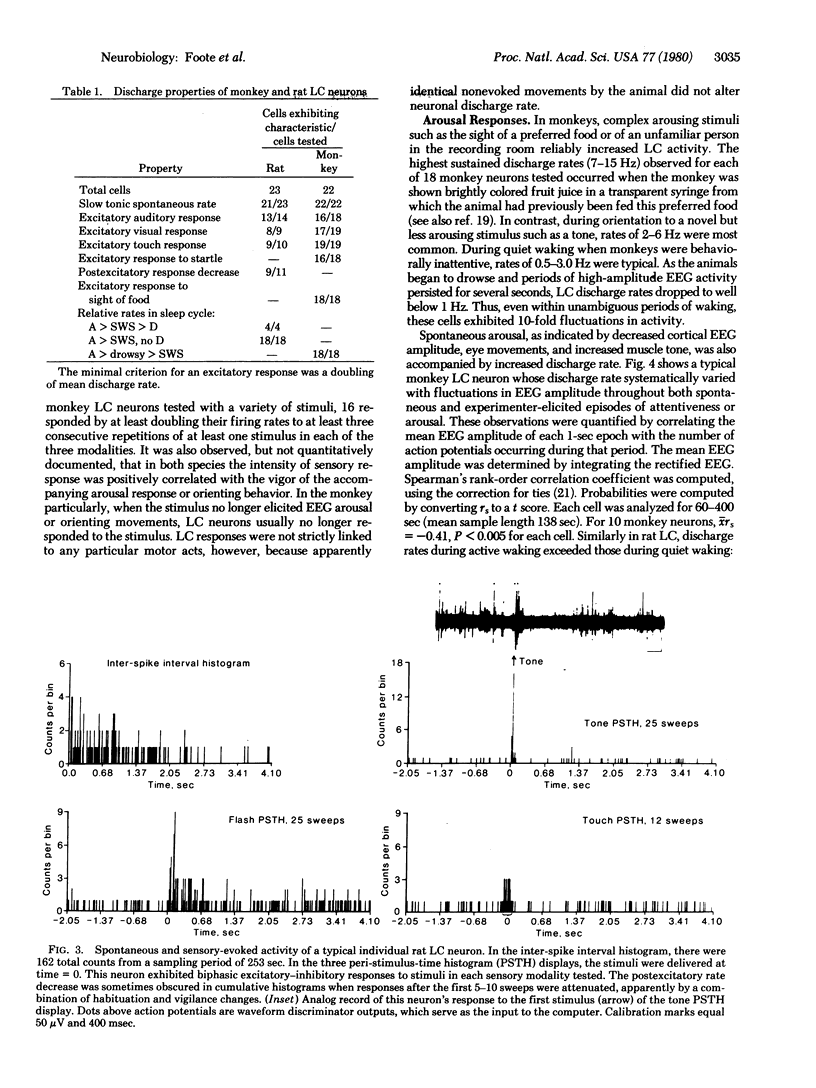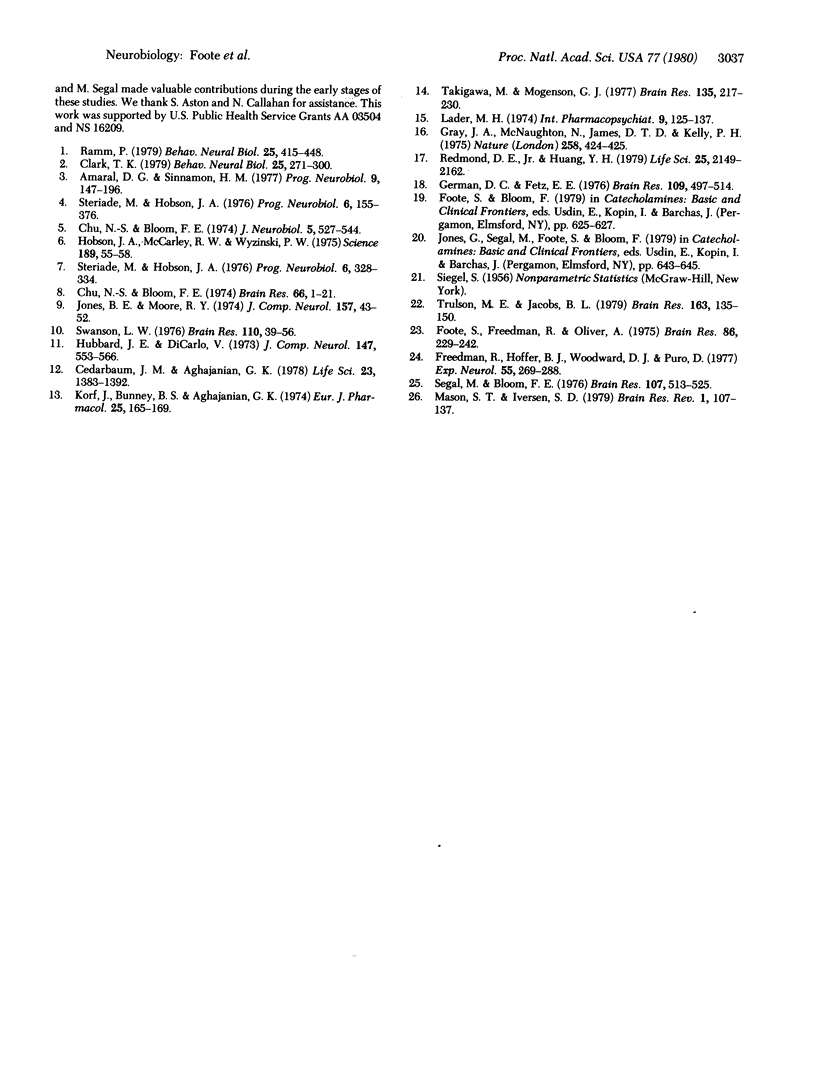Abstract
By means of extracellular recordings, individual norepinephrine-containing neurons in the locus coeruleus of unanesthetized behaviorally responsive rats and squirrel monkeys were found to respond to specific sensory and behavioral conditions. In rats, distinct clusters of action potentials followed the presentation of various nonnoxious auditory, visual, or somatosensory stimuli at latencies of 15-60 msec. Increased discharge rates were also seen during periods of spontaneous electroencephalogram arousal in both species. In monkeys, these cells responded most vigorously to complex arousing stimuli such as a preferred food. Because the noradrenergic innervation of most forebrain regions arises from the locus coeruleus, these results allow prediction of situations under which this massive projection system would be active and suggest a physiological role for this chemically identified network in specific behavioral processes.
Full text
PDF




Images in this article
Selected References
These references are in PubMed. This may not be the complete list of references from this article.
- Amaral D. G., Sinnamon H. M. The locus coeruleus: neurobiology of a central noradrenergic nucleus. Prog Neurobiol. 1977;9(3):147–196. doi: 10.1016/0301-0082(77)90016-8. [DOI] [PubMed] [Google Scholar]
- Cedarbaum J. M., Aghajanian G. K. Activation of locus coeruleus neurons by peripheral stimuli: modulation by a collateral inhibitory mechanism. Life Sci. 1978 Oct 2;23(13):1383–1392. doi: 10.1016/0024-3205(78)90398-3. [DOI] [PubMed] [Google Scholar]
- Chu N. S., Bloom F. E. Activity patterns of catecholamine-containing pontine neurons in the dorso-lateral tegmentum of unrestrained cats. J Neurobiol. 1974;5(6):527–544. doi: 10.1002/neu.480050605. [DOI] [PubMed] [Google Scholar]
- Clark T. K. The locus coeruleus in behavior regulation: evidence for behavior-specific versus general involvement. Behav Neural Biol. 1979 Mar;25(3):271–300. doi: 10.1016/s0163-1047(79)90393-5. [DOI] [PubMed] [Google Scholar]
- Foote S. L., Freedman R., Oliver A. P. Effects of putative neurotransmitters on neuronal activity in monkey auditory cortex. Brain Res. 1975 Mar 21;86(2):229–242. doi: 10.1016/0006-8993(75)90699-x. [DOI] [PubMed] [Google Scholar]
- Freedman R., Hoffer B. J., Woodward D. J., Puro D. Interaction of norepinephrine with cerebellar activity evoked by mossy and climbing fibers. Exp Neurol. 1977 Apr;55(1):269–288. doi: 10.1016/0014-4886(77)90175-3. [DOI] [PubMed] [Google Scholar]
- German D. C., Fetz E. E. Responses of primate locus coeruleus and subcoeruleus neurons to stimulation at reinforcing brain sites and to natural reinforcers. Brain Res. 1976 Jun 18;109(3):497–514. doi: 10.1016/0006-8993(76)90030-5. [DOI] [PubMed] [Google Scholar]
- Gray J. A., McNaughton N., James D. T., Kelly P. H. Effect of minor tranquillisers on hippocampal theta rhythm mimicked by depletion of forebrain noradrenaline. Nature. 1975 Dec 4;258(5534):424–425. doi: 10.1038/258424a0. [DOI] [PubMed] [Google Scholar]
- Hobson J. A., McCarley R. W., Wyzinski P. W. Sleep cycle oscillation: reciprocal discharge by two brainstem neuronal groups. Science. 1975 Jul 4;189(4196):55–58. doi: 10.1126/science.1094539. [DOI] [PubMed] [Google Scholar]
- Hubbard J. E., Di Carlo V. Fluorescence histochemistry of monoamine-containing cell bodies in the brain stem of the squirrel monkey (Saimiri sciureus). I. The locus caeruleus. J Comp Neurol. 1973 Feb 15;147(4):553–566. doi: 10.1002/cne.901470409. [DOI] [PubMed] [Google Scholar]
- Jones B. E., Moore R. Y. Catecholamine-containing neurons of the nucleus locus coeruleus in the cat. J Comp Neurol. 1974 Sep 1;157(1):43–51. doi: 10.1002/cne.901570105. [DOI] [PubMed] [Google Scholar]
- Korf J., Bunney B. S., Aghajanian G. K. Noradrenergic neurons: morphine inhibition of spontaneous activity. Eur J Pharmacol. 1974 Feb;25(2):165–169. doi: 10.1016/0014-2999(74)90045-4. [DOI] [PubMed] [Google Scholar]
- Lader M. The peripheral and central role of the catecholamines in the mechanisms of anxiety. Int Pharmacopsychiatry. 1974;9(3):125–137. doi: 10.1159/000468126. [DOI] [PubMed] [Google Scholar]
- Mason S. T., Iversen S. D. Theories of the dorsal bundle extinction effect. Brain Res. 1979 Jul;180(1):107–137. doi: 10.1016/0165-0173(79)90018-3. [DOI] [PubMed] [Google Scholar]
- Ramm P. The locus coeruleus, catecholamines, and REM sleep: a critical review. Behav Neural Biol. 1979 Apr;25(4):415–448. doi: 10.1016/s0163-1047(79)90212-7. [DOI] [PubMed] [Google Scholar]
- Redmond D. E., Jr, Huang Y. H. Current concepts. II. New evidence for a locus coeruleus-norepinephrine connection with anxiety. Life Sci. 1979 Dec 24;25(26):2149–2162. doi: 10.1016/0024-3205(79)90087-0. [DOI] [PubMed] [Google Scholar]
- Segal M., Bloom F. E. The action of norepinephrine in the rat hippocampus. IV. The effects of locus coeruleus stimulation on evoked hippocampal unit activity. Brain Res. 1976 May 14;107(3):513–525. doi: 10.1016/0006-8993(76)90141-4. [DOI] [PubMed] [Google Scholar]
- Steriade M., Hobson J. Neuronal activity during the sleep-waking cycle. Prog Neurobiol. 1976;6(3-4):155–376. [PubMed] [Google Scholar]
- Swanson L. W. The locus coeruleus: a cytoarchitectonic, Golgi and immunohistochemical study in the albino rat. Brain Res. 1976 Jun 25;110(1):39–56. doi: 10.1016/0006-8993(76)90207-9. [DOI] [PubMed] [Google Scholar]
- Takigawa M., Mogenson G. J. A study of inputs to antidromically identified neurons of the locus coeruleus. Brain Res. 1977 Oct 28;135(2):217–230. doi: 10.1016/0006-8993(77)91027-7. [DOI] [PubMed] [Google Scholar]
- Trulson M. E., Jacobs B. L. Raphe unit activity in freely moving cats: correlation with level of behavioral arousal. Brain Res. 1979 Mar 9;163(1):135–150. doi: 10.1016/0006-8993(79)90157-4. [DOI] [PubMed] [Google Scholar]




